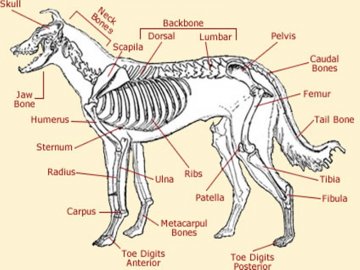Wolf Anatomy
 The gray wolf is the largest member of the Canid family. This type of wolf stands about 26 inches to 38 inches at its shoulder and has a length between 40 and 58 inches from its head to the base of its tail. The tail can be as long as 20 inches, but in most cases, it is shorter than 13 inches. The male wolf is generally 15 to 20% larger than the female.
The gray wolf is the largest member of the Canid family. This type of wolf stands about 26 inches to 38 inches at its shoulder and has a length between 40 and 58 inches from its head to the base of its tail. The tail can be as long as 20 inches, but in most cases, it is shorter than 13 inches. The male wolf is generally 15 to 20% larger than the female.
Weight
The weight of a wolf can vary in North American wolves ranging from 40 pounds to 175 pounds. The average weight is in the range of 60 to 100 pounds.
Head and Muzzle
A wolf has 200 million smelling cells inside its nose. This means it can actually smell 100 times better than a human. Actually, wolves can smell and see deer from a mile away. A wolf also has total of 42 teeth which includes four canines. They use the sharp teeth to grab, wound and kill their prey. At times, wolves use the back teeth for crushing the bones and meat into tiny pieces. The front teeth are used to pull the skin. The wolf’s tongue is very rough and is used to clean the meat off the bones. A wolf moves its ears from one side to the other to determine the source of sound. They have great eyesight, a strong sense of smell, and acute hearing.
Body, Fur and Tail
A wolf’s body is very strong and powerful, making it easier to kill large prey like a deer or elk. Wolves have two layers of fur. The top layer is longer and it is used to keep a wolf dry. The bottom layer is shorter which serves to keep the wolf warm.
Wolves use their tails to communicate with each other. Their tail’s position and the state of their fur are used to send specific massages to other wolves and animals in the area.
Legs and Feet
A wolf’s toes spread whenever they step in snow which helps them avoid sinking. A wolf makes its legs much longer so it can run with great speed and catch the faster prey. A wolf has four toes on its hind feet and five toes on its fore feet.
Skeleton and Brain
The wolf’s skeleton is adapted to its lifestyle. The bones are strong and this gives them power to bring down large prey like deer, moose, elks or caribou. The interlocked foreleg bones, narrow collarbones, and the adapted wrist bones give the wolf its superior speed and strength.
Wolves have very long skulls which are typical of carnivorous animals. This houses extensive strong cheek muscles that are important for holding onto their prey as they kill it and consume it.
Inside the skull is the wolf’s brain. A wolf has a large brain capacity and the skull capacity gives adequate space for the advanced cerebral cortex (the brain). This is necessary for coordinating group social activities and much more.
